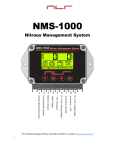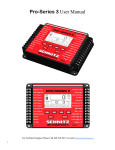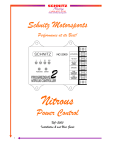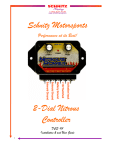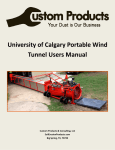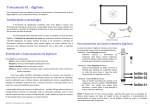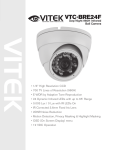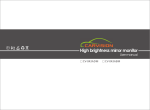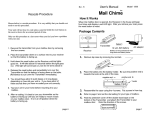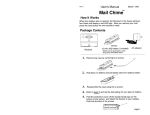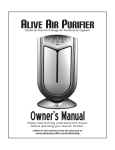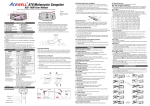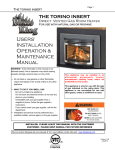Download Micro Storm User Manual, Rev A.pub
Transcript
MICRO STORM 2-Stage, Dual Ramp Progressive Nitrous Controller [email protected] [email protected] 1 Product descrip on—The Micro Storm progressive nitrous controller provides control for two stages of nitrous with a maximum of five setups (user can choose one of five setups). Each stage has independent control parameters (op onal dual ramp feature can be turned ON by user) and are controlled by a single ac va on input. A Clutch/Trans Brake input is provided for launch control. When the Clutch/Trans Brake input is ac ve (+12 volt applied) the nitrous ac va on is ignored un l the Clutch/Trans Brake input is released. This eliminates the need for addi onal relays when staging at wide open thro le. The ac va on input can be configured for +12 volt ac va on or TPS (thro le posi on sensor) ac va on. When a TPS is used the closed thro le voltage and WOT (wide open thro le) are user programmable with either manual adjustment or using Live sensor readings. The TPS input works with either a rising or falling signal, the only requirement is that the signal must span a minimum of 2.5 volts. If the entered values for closed and WOT thro le voltages are less than 2.5 volt span an error code will be displayed un l corrected and the unit will be disabled. There is an integrated RPM window switch func on with a wide range of tach signal input frequencies available. This feature is disabled if NO tach input signal is present. Please see parameter sec on for more opera onal informa on and how to program the unit. Important Informa on ‐ When using a conven onal style igni on coil (Not Coil on Plug) you must use Sta c Suppression Igni on Wires with this Controller. Cau on ‐ Do NOT submerge Controller in liquid or directly wash unit with liquid of any type! (Do NOT spray when washing vehicle!) It is the responsibility of the purchaser to follow all guidelines and safety procedures supplied with this product and any other manufactures product used with this product. It is also the responsibility of the purchaser to determine compa bility of this device with the vehicle and other components. Shu Electronics & Engineering LLC assumes no responsibility for damages resul ng from accident, improper installa on, misuse, abuse, improper opera on, lack of reasonable care, or all previously stated reasons due to incompa bility with other manufacturer's products. Shu Electronics & Engineering LLC assumes no responsibility or liability for damages incurred from the use of products manufactured or sold by Shu Electronics & Engineering LLC on vehicles used for compe on racing. Shu Electronics & Engineering LLC neither recommends nor approves the use of products manufactured or sold by Shu Electronics & Engineering LLC on vehicles which may be driven on public highways or roads, and assumes no responsibility for damages incurred from such use. It is the purchaser’s responsibility to check the state and local laws pertaining to the use of Nitrous Oxide for racing applica ons. Shu Electronics & Engineering LLC does not recommend nor condone the use of its products for illegal street racing. Warranty Shu Electronics & Engineering LLC warrants to the original purchaser that the controller shall be free from defects in parts and workmanship under normal use for 180 days from the date of purchase. Shu Electronics & Engineering LLC obliga on under this warranty is limited to the repair or replacement of any component found to be defec ve when returned postpaid to Shu Electronics & Engineering LLC . The Controller must be returned with evidence of place and date of purchase or warranty will be void. The warranty will not apply if the controller has been installed incorrectly, repaired, damaged, or tampered with by misuse, negligence or accident. 2 Programming bu on descrip on. ENTER—Accept and enter programming mode. UP—Increment value up or change selec on. DOWN—Decrement value down or change selec on. ESC—Press “ENTER” + “DOWN” for ESC key. COMBO—Press “UP” + “DOWN” for COMBO key. Parameter list, (G) = global, (C) = current setup. 1—(G) Current ac ve setup, 5 available 18—(G) Stage2 solenoid pulse frequency, 10 to 40 hZ 2—(C) Nitrous delay me, Stage1 19—(G) Tach signal input frequency 3—(C) Nitrous start percent, Stage1 20—(G) Nitrous ON rpm 4—(C) Nitrous final percent1, Stage1 21—(G) Nitrous OFF rpm 5—(C) Nitrous build me1, Stage1 22—(G) Timer/Shi Light Output Select (Timer = 0, Shi Light = 1) 6—(C) Nitrous delay me, Stage2 7—(C) Nitrous start percent, Stage2 8—(C) Nitrous final percent1, Stage2 23—(G) Timer delay or Shi RPM 24—(G) Turn dual ramp op on ON/OFF (OFF = 0, ON = 1) 9—(C) Nitrous build me2, Stage2 Dual ramp op onal parameters 10—(G) Resume mode, Hold & Wait or Reset (Reset = 0, Hold & Wait = 1) 25—(C) Nitrous final percent2, Stage1 11—(G) Main mer period, 20 to 300 seconds 12—(G) TPS enable, use TPS signal for ac va on (Disable = 0, Enable = 1) 26—(C) Nitrous build me2, Stage1 27—(C) Nitrous final percent2, Stage2 28—(C) Nitrous build me2, Stage2 13—(G) TPS closed thro le volts, manual adjust 14—(G) TPS wide open thro le volts, manual adjust 15—(G) TPS percentage for ac va on, 70% to 100% 16—(G) Set TPS closed & WOT voltage with Live data 17—(G) Stage1 solenoid pulse frequency, 10 to 40 hZ 3 “Global” parameters are se ngs that are applied no ma er which setup is selected. “Current” setup parameters are se ngs that control the individual nitrous stages. Such as delay, start percent, final percent, etc… There are five setups available, this allows the user to change between preprogrammed nitrous setups easily. Parameter #1 controls which setup is selected (currently ac ve). Ready mode, the controller must be in Ready mode to be ac vated. This is the default mode when the unit is powered up. The display will read “r 1” if the current setup is #1. “r 2” for setup #2, etc… The “Current Setup” can be changed from the ready screen by pressing and holding either the “UP” or “DOWN” bu on for 2.5 seconds. To return all of the se ngs to factory default press and hold the “ESC” bu ons for 20 seconds while in ready mode. Programming mode, to enter programming mode the controller must be in the ready state. The display will read “r 1” if the current setup is #1. “r 2” for setup #2, etc… To get to the ready screen press the “ESC” bu ons or this is the default screen when the unit is powered up. From the ready screen press and hold the “ENTER” bu on for 2.5 seconds. When the display reads “PPP” release the bu on. The first parameter will now be selected and the display will read “P. 1”, use the “UP”, “DOWN” bu ons to scroll through all of the parameters. The parameter count will roll over if the minimum or maximum selec on is exceeded. This allows for quick access to the op onal Dual Ramp parameters if they are turned ON. Once the desired parameter has been selected press and hold the “ENTER” bu on for 1 second. When the display reads “PPP” release the bu on. Use the “UP”, “DOWN” bu ons to adjust the se ng. The new se ng is automa cally saved as it adjusted. Press and hold the “UP”, “DOWN” bu ons for accelerated adjust rate. Press the “ENTER” bu on to return to the parameter selec on menu. Con nue selec ng and adjus ng any parameters that need to be set. You can exit the programming mode at any me by pressing the “ESC” bu ons. Note—you do NOT have to go through all of the se ngs. Live Data mode, to enter live data mode the controller must be in the ready state. The display will read “r 1” if the current setup is #1. “r 2” for setup #2, etc… To get to the ready screen press the “ESC” bu ons or this is the default screen when the unit is powered up. From the ready screen press and hold both the “UP” & “DOWN” (COMBO) bu ons for 2.5 seconds. When the display reads “0.00” release the bu ons. The display will now show the signal voltage applied to the Ac va on/TPS input. If a voltage greater than 5.00 volts is applied the display will read a maximum of 5.00 volts. No damage will be done if a +12 volt signal is applied to this input. Press the “DOWN” bu on to display engine RPM and the “UP” bu on to return to ac va on input voltage. Press “ESC” bu ons to exit to the ready screen. 4 Please read page 4 “Programming mode” for instruc ons on how to adjust individual parameters. 1—Current Setup, this se ng controls which setup is ac ve. Valid range is 1 to 5 in increments of 1. Stage1 se ngs 2—Nitrous Delay Time Stage1, this se ng controls the delay me in seconds for nitrous stage1. Valid range is 0.00 to 9.99 in increments of .01 second. 3—Nitrous Start Percent Stage1, this se ng controls the start percentage for nitrous stage1. If there is a delay value programmed for stage1 the start percentage will not be applied un l the delay mer has expired. Use this value to control the ini al nitrous power applied. Valid range is 10% to 100% in 1% increments. 4—Nitrous Final Percent1—Stage1, this se ng controls the final or maximum nitrous power applied if the “Dual Ramp” feature is OFF. The nitrous power ramp will be the start percentage to the final percentage and the ramp me is controlled by the build me se ng. The start percent can be lower than the final percent allowing for power to be taken away over me if desired. Valid range is 10% to 100% in 1% increments. 5—Nitrous Build Time1—Stage1, this se ng controls the me it takes stage1 to go from the star ng percentage to the final percentage. The nitrous will progressively ramp from the start to final se ng in the me programmed for this parameter. A shorter me (example 0.2 second) will create a very aggressive ramp and a longer me (example 9.9 seconds) will create a smoother applica on of power. Valid range is 0.0 second to 9.9 seconds in .1 second increments. Stage2 se ngs 6—Nitrous Delay Time Stage1, this se ng controls the delay me in seconds for nitrous stage1. Valid range is 0.00 to 9.99 in increments of .01 second. 7—Nitrous Start Percent Stage1, this se ng controls the start percentage for nitrous stage1. If there is a delay value programmed for stage1 the start percentage will not be applied un l the delay mer has expired. Use this value to control the ini al nitrous power applied. Valid range is 10% to 100% in 1% increments. 8—Nitrous Final Percent1—Stage1, this se ng controls the final or maximum nitrous power applied if the “Dual Ramp” feature is OFF. The nitrous power ramp will be the start percentage to the final percentage and the ramp me is controlled by the build me se ng. The start percent can be lower than the final percent allowing for power to be taken away over me if desired. Valid range is 10% to 100% in 1% increments. 9—Nitrous Build Time1—Stage1, this se ng controls the me it takes stage1 to go from the star ng percentage to the final percentage. The nitrous will progressively ramp from the start to final se ng in the me programmed for this parameter. A shorter me (example 0.2 second) will create a very aggressive ramp and a longer me (example 9.9 seconds) will create a smoother applica on of power. Valid range is 0.0 second to 9.9 seconds in .1 second increments. 5 Please read page 4 “Programming mode” for instruc ons on how to adjust individual parameters. 10—Resume Mode—Hold & Wait or Reset, This se ng allows the Progressive system to Hold & Wait when the Ac va on signal is removed. Example - the thro le is li ed due to wheel spin or ? This allows the Progressive system to resume at the point where the thro le was li ed. If this op on is OFF the Progressive system and All Timers will reset each me the Ac va on is removed. 0 = Hold & Wait is OFF, Reset mode. 1 = Hold & Wait is ON. 11—Main mer period, 20 to 300 seconds, this controls the total me elapsed before a System Timeout occurs. This limits the total amount of me the solenoids can be On if the Ac va on signal is never removed. This se ng also allows the system to be used with Wait & Hold op on and the Progressive Timers will reset a er the Timeout Period has elapsed and the Ac va on signal is removed. If a reset is needed before the mer has elapsed turn the controller off and back on. This method is by design to prevent the unit from being inadvertently reset during opera on. Valid range is 20 to 300 seconds in 1 second increments. 12—TPS enable, use TPS signal for ac va on, this se ng determines the ac va on input func on. The ac va on input can be configured for +12 volt ac va on or to read a TPS (thro le posi on sensor) signal. When configured for +12 volt ac va on any voltage above 4.00 volts will be accepted as ON. When configured for TPS signal the closed thro le voltage and WOT (wide open thro le) voltage will need to be programmed for proper opera on. A voltage span of at least 2.50 volts between closed and WOT thro le posi on is required. An error code will be displayed on the “Ready” screen if this condi on is not met. 0 = TPS enable OFF, +12 volt ac va on mode. 1 = TPS enable ON, must configure for proper opera on. 13—TPS closed thro le volts—manual adjust, this se ng is only used if TPS enable op on is ON. The value of this se ng should be the closed thro le posi on voltage. See parameter #16 to configure using live TPS data. Valid range is 0.00 to 5.00 volts in .01 volt increments. 14—TPS wide open thro le volts—manual adjust, this se ng is only used if TPS enable op on is ON. The value of this se ng should be the WOT (wide open thro le) thro le posi on voltage. See parameter #16 to configure using live TPS data. Valid range is 0.00 to 5.00 volts in .01 volt increments. 15—TPS percentage for ac va on, this se ng is only used if TPS enable op on is ON. This se ng determines the TPS percent at which system ac va on will occur. Valid Range is 70 to 100 percent in 1 percent increments. 16—Set TPS closed & WOT voltage with Live data, this se ng is only used if TPS enable op on is ON. When using this feature enter programming mode as outlined on page 4. The display will show the TPS voltage, make sure the thro le is in the closed posi on and press “ENTER”. Next open the thro le to maximum posion (on drive by wire cars this may require addi onal help to obtain true open posi on.) and press “ENTER”. These values can be manually adjusted if need using parameters 13 and 14. There must be a minimum voltage span of 2.50 volts between closed and WOT se ngs. The voltage can sweep up or down as long as there is a span of at least 2.50 volts. 6 Please read page 4 “Programming mode” for instruc ons on how to adjust individual parameters. 17—Stage1 solenoid pulse frequency, this se ng determines the stage1 solenoid opera ng frequency in hertz. Typical se ng is from 15 to 25 hertz. There are many different solenoid designs and individual tes ng is the only way to determine what is the best se ng for a given setup. Valid range is 10 to 40 hertz in 1 hertz increments. 18—Stage2 solenoid pulse frequency, this se ng determines the stage1 solenoid opera ng frequency in hertz. Typical se ng is from 15 to 25 hertz. There are many different solenoid designs and individual tes ng is the only way to determine what is the best se ng for a given setup. Valid range is 10 to 40 hertz in 1 hertz increments. 19—Tach signal input frequency, this se ng determines the number of tach signal input pulses per revoluon of the cranksha . If this se ng is in-correct the RPM reading will not correspond to actual engine speed. 0 = 1 pulse per 2 revolu ons (Coil on Plug applica ons). 1 = 1 pulse per revolu on. 2 = 1.5 pulse per revolu on (3-cylinder applica ons). 3 = 2 pulse per revolu on. 4 = 2.5 pulse per revolu on (5-cylinder applica ons). 5 = 3 pulse per revolu on. 6 = 4 pulse per revolu on. 7 = 5 pulse per revolu on. 20—Nitrous ON rpm, this is the minimum RPM required for nitrous ac va on. If there is no tach input signal this feature is disabled. This se ng MUST be lower than the Nitrous Off RPM. Valid range is 0 to 16,000 RPM in 100 RPM increments. 21—Nitrous OFF rpm, this is the minimum RPM required for nitrous ac va on. If there is no tach input signal this feature is disabled. This se ng MUST be greater than the Nitrous On RPM. Valid range is 0 to 16,000 RPM in 100 RPM increments. 22—Timer / Shi Light Select, this se ng determines if the Relay Output func ons as a Timer with Delay or a RPM controlled Shi Light Output. 0 = Timer func on, 1 = Shi Light func on. 23—Timer func on selected, Delay in seconds before the output turns on. Valid range is 0.00 to 9.99 in .01 second increments. Shi Light func on selected, RPM that output will turn on. Valid Range is 0 to 16,000 RPM in 100 RPM increments. 7 Please read page 4 “Programming mode” for instruc ons on how to adjust individual parameters. 24—Turn dual ramp op on ON/OFF, this se ng can be used to enable a dual ramp feature. When the dual ramp feature is ON there is a second final percentage and a second build me for each stage of nitrous. This feature can be used to limit nitrous power during launch and then use the second ramp to aggressively apply power once the vehicle is moving and weight transfer has occurred. Example—Start% = 20, Final% 1 = 35, Build Time1 = 2.5 seconds, Final% 2 = 100, Build Time2 = 1 second. 0 = Dual ramp op on off. 1 = Dual ramp op on on. Dual ramp op onal parameters 25—Nitrous Final Percent2—Stage1, this se ng controls the final or maximum nitrous power applied if the “Dual Ramp” feature is ON. The nitrous power ramp will be the start percentage to final percent #1, final percent #1 to final percent #2. The ramp me is controlled by the build me #1 and build me #2 se ngs. The progressive ramps can be programmed to increase or decrease the nitrous power. Valid range is 10% to 100% in 1% increments. 26—Nitrous Build Time2—Stage1, this se ng controls the me it takes stage1 to go from final percent #1 to the final percent #2. A shorter me (example 0.2 second) will create a very aggressive ramp and a longer me (example 9.9 seconds) will create a smoother applica on of power. Valid range is 0.0 second to 9.9 seconds in .1 second increments. 27—Nitrous Final Percent2—Stage2, this se ng controls the final or maximum nitrous power applied if the “Dual Ramp” feature is ON. The nitrous power ramp will be the start percentage to final percent #1, final percent #1 to final percent #2. The ramp me is controlled by the build me #1 and build me #2 se ngs. The progressive ramps can be programmed to increase or decrease the nitrous power. Valid range is 10% to 100% in 1% increments. 28—Nitrous Build Time2—Stage2, this se ng controls the me it takes stage2 to go from final percent #1 to the final percent #2. A shorter me (example 0.2 second) will create a very aggressive ramp and a longer me (example 9.9 seconds) will create a smoother applica on of power. Valid range is 0.0 second to 9.9 seconds in .1 second increments. 8 9 Important Informa on… Ba ery Ground, the best place to connect the Black, 16 ga wire is directly to the ba ery nega ve terminal. If this is NOT possible then the connec on should be to the frame. There MUST be a quality, large diameter ground cable going from the ba ery nega ve terminal to the frame if the frame connec on method is used. TPS Signal Connec on, the installer must determine the proper wire to obtain the thro le posi on signal. If a wiring diagram is not available a volt meter can be used to locate the proper wire. 1—locate the thro le posi on sensor wires. 2—connect the nega ve lead of the voltmeter to a good ground. 3—with key on probe the wires with the voltmeter, there should be a signal ground (will read 0.0 or close to 0.0 volts), a signal reference voltage (typically 4.90 to 5.00 volts), and the signal wire. The voltage on the signal wire will sweep when the thro le is moved. The wire with the changing voltage is the signal wire. The voltage may be rising or falling. 4—insure that there is a voltage change of at least 2.50 volts when moving the thro le from the closed posion to wide open posi on. If there is not at least a 2.50 volt span then the TPS signal cannot be used to trigger the ac va on input. 5—you can record the closed and wide open thro le voltages to manually enter into the setup parameters or use Live Data mode as outlined in the programming instruc ons. Tach (RPM) Input Signal, the tach input signal can be connected to the coil nega ve terminal or a dedicated square wave signal from the ECM or other source. Some ECM applica ons do NOT have a dedicated tach signal by default and may be turned ON using a ermarket programming solu ons. These ECM’s do NOT provide a pull-up resistor internally and a 4.7 kohm, 1/4 wa resistor will need to be connected from +12V to the tach signal wire. 10











